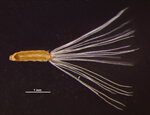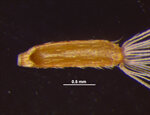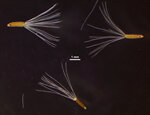Taxonomy
Conyza bonariensis (L.) Cronquist, Bull. Torrey Bot. Club lxx. 632. 1943.Common synonyms
Erigeron bonariensis L. Sp. Pl. 2: 863. 1753.
Conyza is not distinct from Erigeron, and the name cited here as a synonym would be more scientifically correct. The species is retained here as a Conyza merely to avoid confusion.
Common name
Flaxleaf fleabane, hairy fleabane
Description
Propagule or dispersal unit is the fruit with pappus. Fertile part 1-2 mm long, 0.2-0.5 mm wide, in side view widest in upper part (obovoid) or widest in the middle, +/- straight, the upper (apical) end narrowing, in cross-section flattened, basal scar (carpopodium) pronounced and well-differentiated, central, rarely off to the side (oblique) or at least asymmetric, beak (=thinner sterile stalk between seed and pappus) absent, wings absent, fruit surface light brown or straw, smooth (except at cellular level), with simple straight hairs, thickened margin absent or present (by misinterpretation), thick margin hairs simple straight hairs, longitudinal ribs present, 2, their surfaces smooth, with simple straight hairs.
Pappus type bristles / hairs, pappus elements all +/- similar, up to 3-5 mm long, in one row, pappus elements numerous, persistent, the individual bristles rough / serrated (barbellate), +/- equal width along length, white / translucent.
Notes: The key accommodates the interpretation of surface structures either as two longitudinal ribs or as a thickened margin. Unfortunately, the fruits of the various species of Erigeron / Conyza are all rather similar and hard to differentiate. Erigeron generally has an additional longitudinal rib on the fruit surface whereas Conyza generally has only the two marginal ribs or thickened margins, depending on interpretation. Among the Conyza, C. bonariensis has the largest fruits with the fertile part 1-2 mm long and the pappus 3-5 mm long, but there is a large overlap with the other species.
Ecology
Annual to biennial herb, fruit wind-dispersed. Temperate to Tropical climates, open but not too heavily disturbed habitats such as wastelands, field margins, roadsides, unused fields, orchards, neglected urban environments.
Native range
South America.
Introduced range
Cosmopolitan.
Past interceptions (Australia): origins
United States, Ecuador, Spain, Italy, Kenya, UAE, Japan, Thailand.
Unidentified species of the same genus from United States, Mexico, Colombia, Ecuador, Argentina, United Kingdom, Spain, Belgium, France, Germany, Italy, Hungary, Slovakia, Kenya, UAE, India, China, Korea, Japan, Thailand, Indonesia, Papua New Guinea, New Zealand.
Past interceptions (Australia): commodities
New vehicles, new tyres, containers, fresh fruit, cut flowers.
Unidentified species of the same genus in/on machinery and parts, agricultural machinery, timber pallets, containers, nursery stock, new vehicles, cut flowers, steel, fresh fruit.


